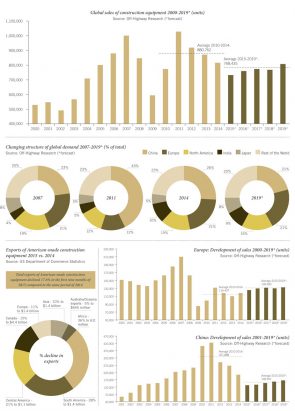Outlook for global construction equipment markets: United States
First published in Global Report: Construction Equipment 2016 as Will earthmovers become the global growth champions?
 The passing of the new US highway Bill and Timetric CIC’s optimism both point to continued growth in the number of new highway contracts in the USA
The passing of the new US highway Bill and Timetric CIC’s optimism both point to continued growth in the number of new highway contracts in the USAIn early December 2015, the US Congress cleared and sent to the White House a five-year, US$305 billion highway bill said to combine the demands of road builders and unions with the wishes of safety advocates and local transit planners
The long-awaited and now delivered bill will provide money for much needed roads and rail projects – creating big growth opportunities for leading construction equipment manufacturers.
In this context, a summer 2015 report by Timetric’s Construction Intelligence Center (CIC) appears prescient. It tipped the US construction industry to pick up over the next five years. Drilling down into its figures, Timetric CIC forecasts that the US construction sector’s average annual growth is set to accelerate in real terms from 1.7% in 2009-2014 to 3.1% until 2019, increasing from US$1 trillion in 2014 to $1.1 trillion in 2019 in real terms. Investments to modernise the country’s ageing infrastructure and renewable energy sector alongside the growing population, which will generate demand for residential buildings, will be one of a number drivers of this growth, says Timetric CIC.
Residential construction was the largest market during the 2009-14 review period and will retain this position, mainly supported by the government’s plans to increase the budget allocation by 1.9% to $46.7 billion in 2015. The budget will, says Timetric CIC, support homeownership, sustainable community development and access to affordable housing to protect homeless and vulnerable families. Moreover, a near 17 billion increase in the country’s total population to 338 billion by 2020 is expected to further increase demand for housing.
Despite the passing of the US highway bill and Timetric CIC’s optimism on the US domestic front, exports of American-made construction equipment declined 17.6% in the first nine months of 2015 compared to the same period of 2014, with a total $10.8 billion shipped to global markets, according to the US Department of Commerce.
All world regions experienced declines, led by Africa – with exports to the continent down by 36% to $611 million. The next biggest export decline was to South America – by 28% to $1.4 billion; followed by Central America – down 21% to $1.1 billion; Canada – down 15% to $4.4 billion; Europe – exports down 11% to $1.4 billion; Asia, where US equipment exports were down 10% to $1.4 billion; and Australia/Oceania exports fell 5% to $645 million.
The Association of Equipment Manufacturers’ (AEM) Benjamin Duyck, AEM director of market intelligence, said: “The third quarter of 2015 marked the 11th consecutive quarter that US construction equipment exports experienced year over year declines. According to AEM’s third quarter North American Construction Equipment Industry Conditions Trends Report initial results, 35% of survey exporters indicated they experienced a decrease in exports while 50.9% of respondents felt the market had remained stable.
Contrary to the second quarter, imports also declined – 5.71% year over year. Declining imports is a bigger signal to the US market, especially now that imports are relatively cheaper under the stronger dollar. In the third quarter AEM industry conditions survey, 42.3% of respondents indicated US demand for equipment was lower this quarter vs. last year, while 30.7% felt the market remained stable. For the next 12 months, overall growth is still expected.
While the global environment is still positive for construction and construction equipment, one of the bigger clouds could be the Chinese market. It is the US’s ninth largest export market for construction equipment and it declined 25% year to date. Another cloud is Brazil, which last week announced its economy was going deeper into a recession after three consecutive quarters of contraction in its GDP. While exports to Canada, our largest trading partner, also decreased, by 15% year to date, Statistics Canada recently reported that the economy returned to quarterly growth.
While it is hard to pinpoint the exact cause of the declining exports, some of the possible explanations may be the difficulties in exporting equipment with engines that require Ultra Low Sulphur Diesel, strengthening local manufacturing industries and a strong US dollar making US manufacturers less competitive. It will be interesting to see where the global economy is going in 2016. While exports might continue to slump, we will also be keeping our eyes on domestic demand and imports.”






